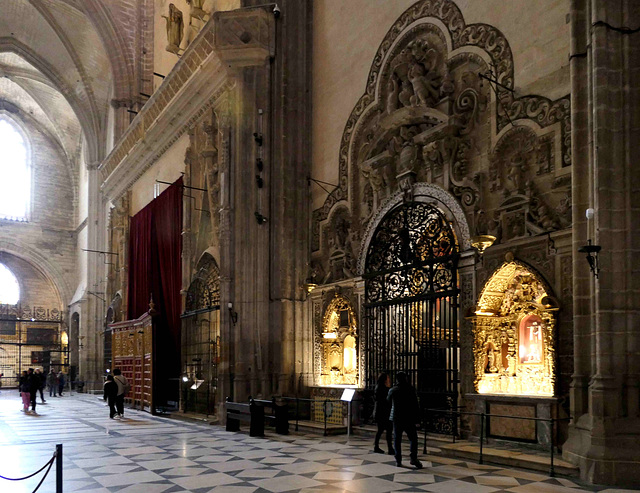IMG 0687-001-Waterloo Bridge
Batalha - Mosteiro da Batalha
Bande - Santa Comba
Sevilla - Catedral de Santa María de la Sede
Sevilla - Catedral de Santa María de la Sede
Sevilla - Real Alcázar de Sevilla
Jerez de la Frontera - Iglesia de San Miguel
Jerez de la Frontera - Iglesia de San Miguel
Jerez de la Frontera - Catedral
Valencia - Catedral de Santa María
Teruel - Catedral de Teruel
Teruel - Catedral de Teruel
Teruel - Catedral de Teruel
Toledo - El Cristo de la Luz
Florence 2023 – Duomo
Salamanca - Catedral Nueva
Salamanca - Catedral Nueva
Toro - Colegiata de Santa María la Mayor
Toro - Colegiata de Santa María la Mayor
Zamora - Catedral de Zamora
Zamora - Catedral de Zamora
Zamora - Catedral de Zamora
twb[23] - Spanish City
twb[23] - white dome
twb[23] - Spanish City dome
dss - Douglas Promenade {5 of 12}
Florence 2023 – Cappelle Medicee – Cappella dei Pr…
IMG 8986-001-St Paul's
Moirax - Notre-Dame
Torino - Santissima Trinità
Florence - Battistero di San Giovanni
IMG 8359-001-All the Cranes
Florence - Cattedrale di Santa Maria del Fiore
Todi - Santa María de la Consolación
Piazza Armerina - Cattedrale di Piazza Armerina
Location
See also...
Keywords
Authorizations, license
-
Visible by: Everyone -
All rights reserved
-
24 visits
Sevilla - Catedral de Santa María de la Sede


Seville was a Roman "colonia" since 45 BC. The important city was looted by the Vandals in 428 and developed into a Bishopric seat under Visigothic rule. After the Moors had defeated the Visigoths in the Battle of Guadalete, they conquered Seville and made it the capital of a province. Normans devastated Seville in 844 but Seville was rebuilt and flourished under the different Moorish dynasties. In 1248 Seville was conquered by the troops of Ferdinand III of Castile. The emigration of thousands of Moors to Northern Africa led to a decrease in economics in the whole area. Seville recovered in the 16th and 17th century when it became the hub of Spanish maritime trade. During this period, the port of Seville had a monopoly on overseas trade. Vespucci and Magellan planned and started their voyages here. As a result of the War of the Spanish Succession, in 1717 Seville lost the transatlantic trade monopoly to Cádiz.
The "Catedral de Santa María de la Sede" was erected between 1401 and 1519 on the remains of the Great Mosque of Seville, built in the 12th century.
With about 11,520m² this is the third-largest church in the world as well as the largest Gothic church. The Cathedral in Cologne covers about 7,900m².
The Great Mosque of Seville was dedicated in 1172 and completed in 1198. It was a rectangular building 113m x 135m including a minaret ("La Giralda") and a courtyard. After the conquest, the mosque was converted into the city's cathedral. The orientation was changed and it was divided into chapels by new walls. In 1401 it was decided to build a new cathedral and replace the mosque, that had served as a cathedral. In 1551, 5 years after construction ended, the crossing lantern ("cimborrio"), collapsed and was rebuilt. It collapsed again in 1888, and work continued until 1903.
The cathedral of today is 115m long and 76 m wide. There are five naves, the vaultig over the central one is 42m high.
The "Catedral de Santa María de la Sede" was erected between 1401 and 1519 on the remains of the Great Mosque of Seville, built in the 12th century.
With about 11,520m² this is the third-largest church in the world as well as the largest Gothic church. The Cathedral in Cologne covers about 7,900m².
The Great Mosque of Seville was dedicated in 1172 and completed in 1198. It was a rectangular building 113m x 135m including a minaret ("La Giralda") and a courtyard. After the conquest, the mosque was converted into the city's cathedral. The orientation was changed and it was divided into chapels by new walls. In 1401 it was decided to build a new cathedral and replace the mosque, that had served as a cathedral. In 1551, 5 years after construction ended, the crossing lantern ("cimborrio"), collapsed and was rebuilt. It collapsed again in 1888, and work continued until 1903.
The cathedral of today is 115m long and 76 m wide. There are five naves, the vaultig over the central one is 42m high.
kiiti, Marco F. Delminho have particularly liked this photo
- Keyboard shortcuts:
Jump to top
RSS feed- Latest comments - Subscribe to the comment feeds of this photo
- ipernity © 2007-2024
- Help & Contact
|
Club news
|
About ipernity
|
History |
ipernity Club & Prices |
Guide of good conduct
Donate | Group guidelines | Privacy policy | Terms of use | Statutes | In memoria -
Facebook
Twitter

Sign-in to write a comment.